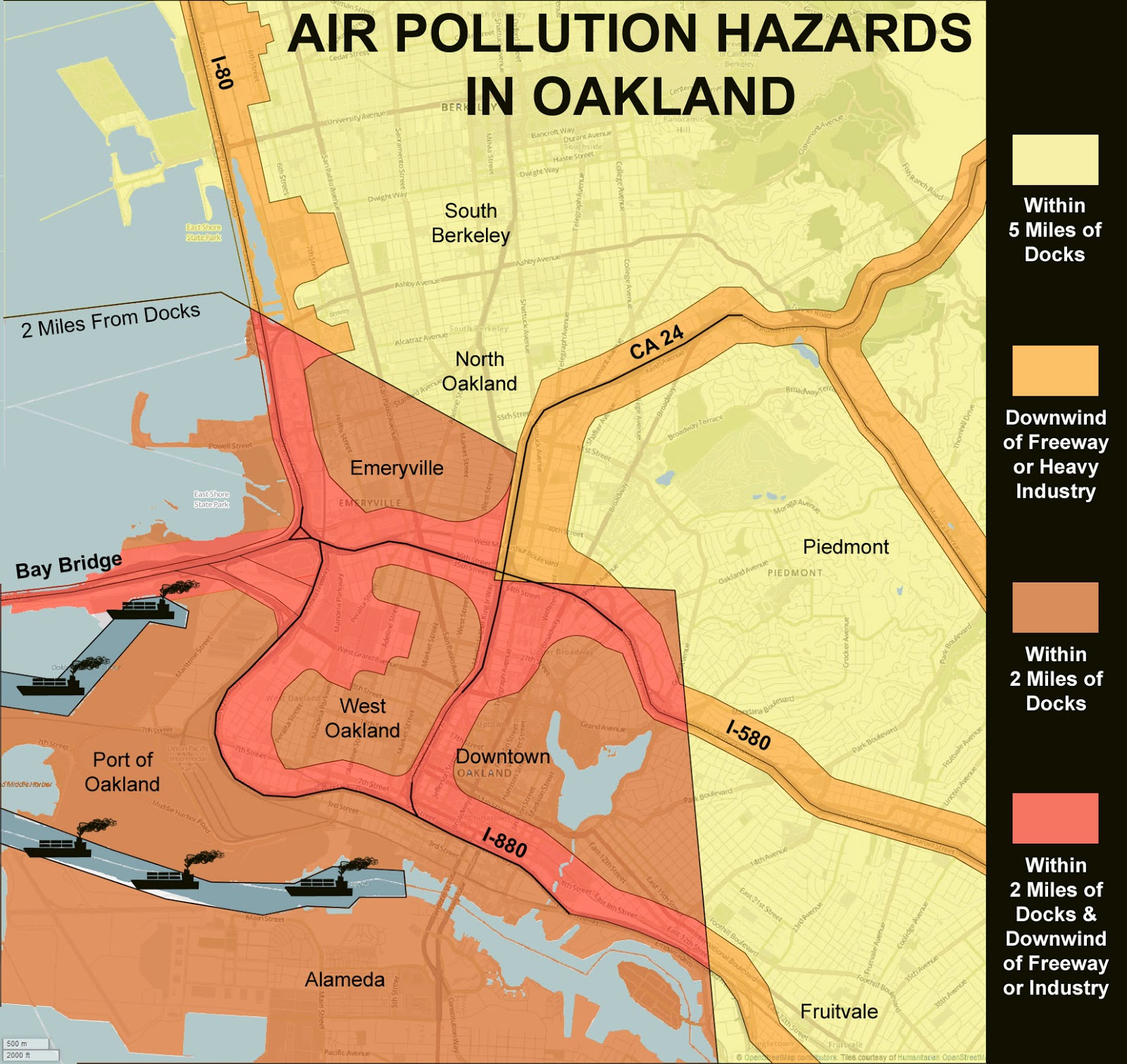Air Quality Index (AQI) and Pollutants

The Air Quality Index (AQI) is a measure of how clean or polluted the air is. It is based on the concentration of five major air pollutants: ground-level ozone, particulate matter (PM2.5 and PM10), carbon monoxide, sulfur dioxide, and nitrogen dioxide. The AQI is divided into six categories, from “good” to “hazardous.”
Oakland’s air quality is generally good, but it can vary depending on the time of year and the weather conditions. The major pollutants contributing to Oakland’s air quality include:
PM2.5
PM2.5 is a type of particulate matter that is 2.5 micrometers or less in diameter. It is emitted from a variety of sources, including vehicles, power plants, and industrial activities. PM2.5 can cause a variety of health problems, including respiratory and cardiovascular disease.
Ozone
Ozone is a gas that is formed when sunlight reacts with other pollutants in the air. It is a major component of smog and can cause a variety of health problems, including respiratory irritation and asthma.
Nitrogen Dioxide
Nitrogen dioxide is a gas that is emitted from vehicles and power plants. It can cause a variety of health problems, including respiratory irritation and asthma.
Sources of Air Pollution

Oakland air quality – Air pollution in Oakland, California, stems from various sources, including traffic, industrial activities, and wildfires. These sources release harmful pollutants into the atmosphere, contributing to the city’s air quality challenges.
Transportation
Transportation is a major source of air pollution in Oakland. Vehicle emissions, particularly from diesel engines, release pollutants such as particulate matter, nitrogen oxides, and hydrocarbons. Idling vehicles also contribute to air pollution by releasing exhaust gases without moving. The high volume of traffic in Oakland, especially during peak hours, exacerbates the impact of transportation-related air pollution.
Health Impacts and Mitigation Strategies: Oakland Air Quality

Prolonged exposure to poor air quality in Oakland poses significant health risks, particularly for vulnerable populations such as children, the elderly, and individuals with respiratory conditions.
Respiratory Issues, Oakland air quality
- Exposure to air pollutants, including particulate matter (PM), ozone (O3), and nitrogen dioxide (NO2), can irritate the respiratory tract, leading to coughing, wheezing, and shortness of breath.
- Long-term exposure to PM has been linked to an increased risk of asthma, chronic bronchitis, and emphysema.
Cardiovascular Disease
- Air pollution can contribute to cardiovascular problems by increasing inflammation and oxidative stress.
- Exposure to PM and NO2 has been associated with an increased risk of heart attacks, strokes, and other cardiovascular events.
Cancer
- Certain air pollutants, such as benzene and diesel exhaust, have been classified as carcinogens by the International Agency for Research on Cancer (IARC).
- Long-term exposure to these pollutants has been linked to an increased risk of lung cancer, leukemia, and other types of cancer.
Mitigation Strategies
Improving air quality in Oakland requires a comprehensive approach that involves reducing emissions from various sources and promoting clean energy.
Reducing Vehicle Emissions
- Encouraging the use of public transportation, walking, and cycling.
- Promoting electric vehicles and low-emission vehicles.
- Implementing stricter emissions standards for vehicles.
Promoting Clean Energy
- Transitioning to renewable energy sources such as solar and wind power.
- Improving energy efficiency in buildings and industries.
- Promoting the use of clean-burning fuels.
The city’s air quality has been a growing concern, with levels of particulate matter and ozone exceeding federal standards. While the news of Justin Timberlake’s arrest justin timberlake arrested has made headlines, it’s crucial to remember the ongoing challenges facing Oakland’s air quality.
Efforts to reduce emissions and improve air quality are essential for the health and well-being of the community.
The gentle breeze carried the scent of wildflowers, a refreshing contrast to the usual smoggy air of Oakland. It was a reminder of the city’s potential for beauty, even amidst the ongoing struggles with air quality. The recent news of Justin Timberlake’s arrest seemed like a distant echo in the tranquility of the park, yet it served as a stark reminder of the complexities of human nature.
As the sun began its descent, casting a golden glow over the city, the air grew heavy again, a tangible manifestation of the challenges that lay ahead.
Oakland’s air quality, often compromised by industrial emissions, can have detrimental effects on our health. In the realm of health, a recent development caught my attention: Justin Timberlake’s involvement in Truvada , a medication used to prevent HIV infection. While this sheds light on the importance of health awareness, it also reminds us of the disparities in healthcare access.
Oakland, with its diverse population, deserves equitable access to clean air and quality healthcare, ensuring the well-being of all its residents.
Oakland’s air quality has been under scrutiny lately, with residents raising concerns about its impact on their health. However, this isn’t the only news making headlines. The recent arrest of Justin Timberlake has sparked discussions about the consequences of driving under the influence.
While these two topics may seem unrelated, they both highlight the importance of responsible decision-making and the potential risks associated with our actions. Oakland’s air quality remains a pressing issue, and it’s crucial that we take steps to improve it for the well-being of our community.
In the bustling streets of Oakland, where the vibrant tapestry of life unfurls, the air quality weaves a complex narrative. From the gentle whispers of the morning breeze to the pungent fumes of traffic, the city’s atmosphere carries a myriad of tales.
Like the enigmatic rumors surrounding Justin Timberlake’s HIV status, the truth about Oakland’s air quality remains shrouded in a veil of uncertainty. Yet, beneath the surface of the city’s hustle and bustle, a deeper story unfolds, a story of resilience and transformation, where the pursuit of cleaner air becomes a symbol of hope for a brighter future.